
Ants are eusocial insects of the family Formicidae and, along with the related wasps and bees, belong to the order Hymenoptera. Ants evolved from vespoid wasp ancestors in the Cretaceous period. More than 13,800 of an estimated total of 22,000 species have been classified. They are easily identified by their geniculate (elbowed) antennae and the distinctive node-like structure that forms their slender waists.

Lycaenidae is the second-largest family of butterflies, with over 6,000 species worldwide, whose members are also called gossamer-winged butterflies. They constitute about 30% of the known butterfly species.
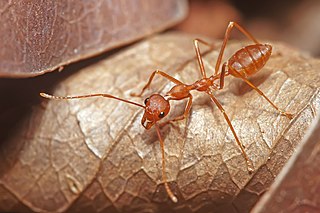
Weaver ants or green ants are eusocial insects of the family Formicidae. Weaver ants live in trees and are known for their unique nest building behaviour where workers construct nests by weaving together leaves using larval silk. Colonies can be extremely large consisting of more than a hundred nests spanning numerous trees and containing more than half a million workers. Like many other ant species, weaver ants prey on small insects and supplement their diet with carbohydrate-rich honeydew excreted by small insects (Hemiptera). Weaver ant workers exhibit a clear bimodal size distribution, with almost no overlap between the size of the minor and major workers. The major workers are approximately 8–10 mm (0.31–0.39 in) in length and the minors approximately half the length of the majors. Major workers forage, defend, maintain, and expand the colony whereas minor workers tend to stay within the nests where they care for the brood and 'milk' scale insects in or close to the nests.

Salim Ali Bird Sanctuary is an estuarine mangrove habitat, which is declared as the bird sanctuary, and located on western tip of the Island of Chorão along the Mandovi River, Goa, in India. The sanctuary is named after Salim Ali, the eminent Indian ornithologist.

Crematogaster is an ecologically diverse genus of ants found worldwide, which are characterised by a distinctive heart-shaped gaster (abdomen), which gives them one of their common names, the Saint Valentine ant. Members of this genus are also known as cocktail ants because of their habit of raising their abdomens when alarmed. Most species are arboreal (tree-dwelling). These ants are sometimes known as acrobat ants.

Gaultheria mucronata is a species of flowering plant in the family Ericaceae, native to southern Argentina and Chile.
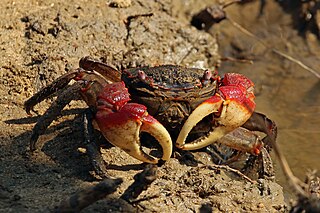
The Southern Africa mangroves are mangrove ecoregion on the Mozambique's southernmost coast and the eastern coast of South Africa.
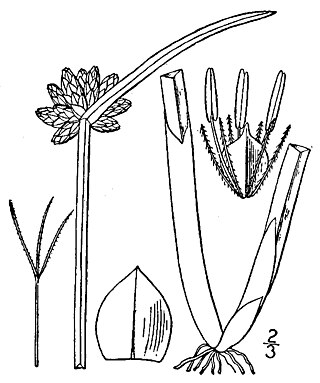
Schoenoplectiella mucronata is a species of flowering plant in the sedge family known by the common names bog bulrush, rough-seed bulrush, and ricefield bulrush. It is native to Eurasia, Africa and Australia. It grows in moist and wet terrestrial habitat, and in shallow water. It is a perennial herb growing from a short, hard rhizome. The erect, three-angled stems grow in dense clumps and can reach a metre tall. The leaves take the form of sheaths wrapped around the base of stem, but they generally do not have blades. The inflorescence is a headlike cluster of cone-shaped spikelets accompanied by an angled, stiff bract which may look like a continuation of the stem.
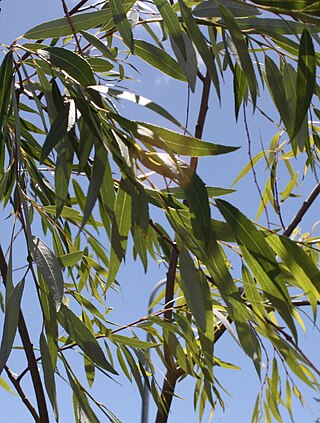
Salix mucronata is a tall, graceful, Semi-Deciduous willow tree. It grows along riverbanks in South Africa, and is used for a wide range of traditional medicines.
The Cape willow is dioecious.

Scotopteryx luridata, the July belle, is a species of moth in the family Geometridae. It is found in most of Europe, except Finland and the Baltic region. Further East it is found in Turkey, Georgia and Transcaucasia.

Scotopteryx mucronata, the lead belle, is a species of moth in the family Geometridae. It is found in most of Europe, Turkey, Ukraine, West Siberia.

Rhizophora mucronata is a species of mangrove found on coasts and river banks in East Africa and the Indo-Pacific region.
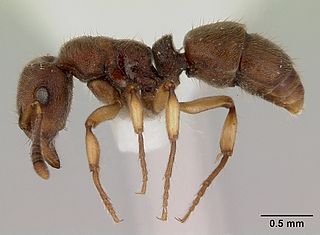
Heteroponerinae is a subfamily of ants in the poneromorph subfamilies group containing three genera in one tribe. The subfamily was created in 2003 when Barry Bolton divided the Ponerinae subfamily into six subfamilies.

Acanthoponera is a Neotropical genus of ants in the subfamily Heteroponerinae. Acanthoponera contains six rarely collected species and a fifth unnamed species mentioned by Brown (1958) only known from a stray gyne.
Acanthoponera goeldii is a species of ant belonging to the genus Acanthoponera. Described in 1912 by Forel, the species is native to North America and South America.

Acanthoponera minor is a species of ant belonging to the genus Acanthoponera. Described in 1899 by Forel, the species is native to North America, Central America and South America.

Acanthoponera peruviana is a species of ant belonging to the genus Acanthoponera. Described in 1958 by Brown, the species is native to South America.

Haworthia mucronata is a species of the genus Haworthia in the family Asphodelaceae, endemic to the Little Karoo region, in the Western Cape Province of South Africa.

Polyrhachis mucronata is a species of ant in the genus Polyrhachis.


















